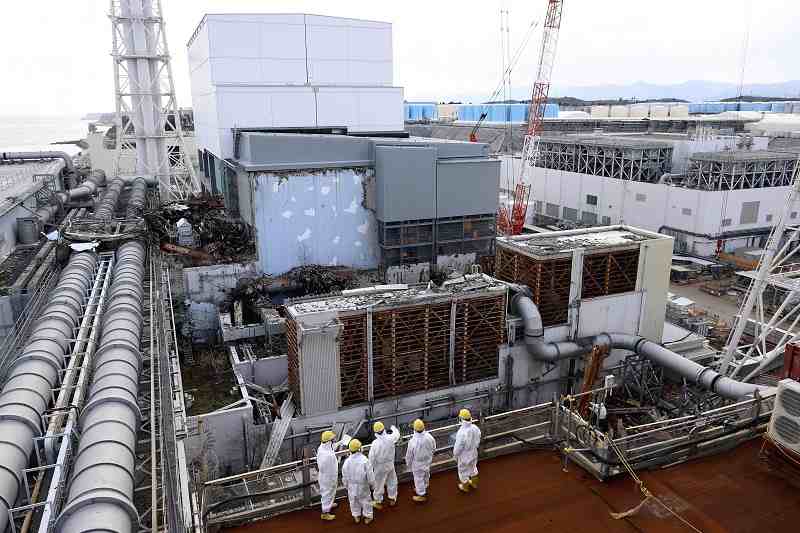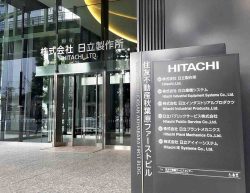
The No. 4 nuclear reactor building is seen from the No. 3 reactor building of the Fukushima No. 1 nuclear power plant on Feb. 4. Wreckage from a hydrogen explosion remains on site.
17:03 JST, March 19, 2021
Tokyo Electric Power Company Holdings, Inc.’s plans to remove fuel debris from melted reactor cores at the Fukushima No. 1 nuclear power plant, a task considered the highest hurdle in the arduous decommissioning process, have been delayed in a setback that speaks to the challenges stymying cleanup efforts at the site a full decade after the disaster.
Although TEPCO had initially planned to begin clearing debris from the No. 2 reactor this year, work had to be postponed until next year, as a robotic arm being developed for the task could not be completed on schedule amid the pandemic.
A roadmap places decommissioning sometime in the next 20 to 30 years. But with only hazy details regarding the next steps on the long road ahead, the future of the plant remains unclear.
Postponed by the pandemic
“We did not want to deviate from the schedule for commencing debris retrieval,” Akira Ono, president of Fukushima Daiichi D&D Engineering Company, told The Yomiuri Shimbun on March 2.
Behind the delay was the worldwide spread of the novel coronavirus. TEPCO intended to deploy a 22-meter-long, 4.6-ton stainless steel robotic arm in the containment vessel to remove a few grams of debris in a test run originally scheduled for later this year. As a result of the pandemic, the British company that developed the arm was left unable to conduct performance tests, and the arm did not arrive in time.
The Japanese government and TEPCO have revised the decommissioning roadmap five times since it was first presented in December 2011, the month when the Fukushima No.1 power plant’s reactors achieved cold shutdown. Yet through each revision, they had still stuck to the plan to start retrieving debris within 10 years and complete the decommissioning process within a 30 to 40-year timeframe. Postponement of the retrieval work until 2022 means they will miss the first of these two schedule targets.
An official at the Economy, Trade and Industry Ministry’s Natural Resources and Energy Agency said a delay of only a year or so would not affect the decommissioning process. Even so, the outlook remains uncertain on when they expect to be able to retrieve all the fuel debris.
The Nos. 1 to 3 reactors are estimated to contain 900 tons of debris, left over when nuclear fuel melted down along with equipment and other structural detritus. It is presumed that the hardness and other properties of the resulting solidified masses varies from location to location, but no one quite knows the full extent of the damage inside the reactors, as the high radiation levels emitted by the debris make it difficult for even robots to draw near.
Retrieval is a delicate process that runs the risk of spreading radioactive material in the event of debris collapse. A proposal to fill the reactors with water in order to suppress the movement of radioactive dust was considered, but ultimately ruled out due to prohibitive reactor damage. Specific operation procedures have yet to be determined.
After the 1986 Chernobyl nuclear power plant disaster, extrication of the solidified nuclear refuse was postponed indefinitely, in favor of instead ensconcing the entire reactor facility in a massive concrete and steel sarcophagus.
Storage of treated water close to limit
The most imminent challenge facing the Fukushima plant is the question of what to do with all the contaminated cooling water that has been pumped through the reactors, along with the rainwater and groundwater that finds its way into the damaged buildings.
TEPCO stores about 1.2 million tons of water in nearly 1,000 tanks on site. The tanks are expected to be full as early as autumn 2022.
Although the water has been treated to remove most of the radioactive substances, the tanks are still liable to leak if damaged by earthquakes or typhoons, and TEPCO is concerned that building any more tanks could hinder decommissioning work.
In February 2020, a government panel of experts compiled a report asserting that it would be realistically feasible to dispose of the treated water in the sea and air. Treated water contains radioactive tritium, but the Nuclear Regulation Authority and the International Atomic Energy Agency have similarly urged TEPCO to release the water.
Tritium-laden wastewater is a byproduct of all nuclear power plants, in Japan and abroad, and cannot be purified with current technology. As a result, power companies simply dilute the treated water to a level that is considered to have no effect on human health or the environment.
Fallout felt for centuries
Other challenges, apart from fuel debris and water storage, will include the disposal of highly radioactive sludge that results from purifying contaminated water, and the large amount of rubble left over after dismantling the reactors. But the roadmap does not specify when dismantling of the reactors is to begin, and the total volume of radioactive emissions remains another unknown quantity.
At Chubu Electric Power Co.’s Hamaoka Nuclear Power Station in Shizuoka Prefecture, decommissioning work has been underway on two of its boiling water reactors — the same style of reactor as those at the Fukushima plant — since fiscal 2009. Chubu Electric plans to spend 27 years to fully decommission those reactors by fiscal 2036.
At the Fukushima No. 1 plant, it will take many years to dismantle all six of its reactors, including the three whose cores have melted.
The Japanese government and TEPCO have yet to present their vision for the distant future, after the decommissioning work has at last been completed.
Last summer, the Atomic Energy Society of Japan estimated that it would take at least 100 years before the site could be reused.
"Business" POPULAR ARTICLE
-

Keidanren Chairman Yoshinobu Tsutsui Visits Kashiwazaki-Kariwa Nuclear Power Plant; Inspects New Emergency Safety System
-

Imports of Rare Earths from China Facing Delays, May Be Caused by Deterioration of Japan-China Relations
-

University of Tokyo Professor Discusses Japanese Economic Security in Interview Ahead of Forum
-

Japan Pulls out of Vietnam Nuclear Project, Complicating Hanoi’s Power Plans
-

Govt Aims to Expand NISA Program Lineup, Abolish Age Restriction
JN ACCESS RANKING
-

Keidanren Chairman Yoshinobu Tsutsui Visits Kashiwazaki-Kariwa Nuclear Power Plant; Inspects New Emergency Safety System
-

Imports of Rare Earths from China Facing Delays, May Be Caused by Deterioration of Japan-China Relations
-

University of Tokyo Professor Discusses Japanese Economic Security in Interview Ahead of Forum
-

Japan Pulls out of Vietnam Nuclear Project, Complicating Hanoi’s Power Plans
-

Govt Aims to Expand NISA Program Lineup, Abolish Age Restriction

























